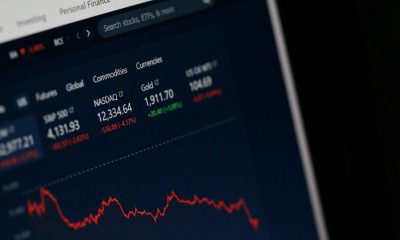Markets
Do central bankers know how to create growth?
Instead of setting unrealistic goals about things they can’t control, central bankers should instead focus on giving the real economic drivers, business owners and managers, the best set of circumstances possible.

Central bankers’ goal was to boost the economy through monetary policy to the point that growth, which should drive up wages, would lead to higher prices. But wages are rising at a snail’s pace, and GDP growth is anemic at best. This leaves the question whether central bankers know how to create growth.
I’m a fan of the Marvel Comics movies, like X-Men and Iron Man.
My lovely wife often catches me watching tidbits of the Avenger films when I sit down in front of the TV to relax for a few minutes. I’ll flip around until I find one, watch just 20 to 30 minutes, then move on to another project in the house.
It drives her nuts!
I know the ending. The characters use their skills to better the world. They have clear goals, choose their targets, and execute. These are nice, neat packages, which is completely unlike the real world.
Unless you ask central bankers.
For some reason, over the last 20 years and especially in the last decade, people have attributed Marvel-like superhuman knowledge and power to those who manage currency, money supply, and interest rates.
And the bankers appear to believe it, even though it’s not just irrational, it’s demonstrably false.
As we peer in the windows of their great halls, these figures traipse around as if in capes and costumes, espousing great theories on what should happen, only to note in their press conferences that the world isn’t turning out according to plan. Right.
Ben Bernanke was no Captain America, Mario Draghi isn’t Iron Man, and Janet Yellen isn’t the Black Widow. And by the way, these characters are fictional!
Central bankers have to live in the real world where drawing lines on a graph is easy, but getting consumers to comply with the economic theory is hard.
We have our own ideas of what to do with our money, thank you very much.
Which gets back to the problem at hand.
Central bankers are full of it… economic theory, that is. But short on success. And the recent conversation about soft inflation targets proves the point.
For years – years! – the Fed has noted a 2% inflation target as measured by the personal consumption expenditure (PCE), which is a bit different from the consumer price index, but close.
The goal was to boost the economy through monetary policy to the point that growth, which should drive up wages, would lead to higher prices. Well, here we are. The PCE now sits just over 2%, with core PCE (minus food and energy), just under the magic level.
But there’s a problem.
Wages are rising at a snail’s pace, and GDP growth is anemic at best.
But hey, don’t fret! We’ve got inflation back! So even though the economy is stumbling and your income is flat, prices are higher!
Brilliant!
So, central bankers are doing what they’ve done before. Changing the target. Two percent inflation isn’t getting the job done, so now they’ll tolerate inflation around 2%, which means they will keep doling out easy money, keeping interest rates lower for longer, as they hope and pray for more growth and higher wages.
If this sounds like the same story we heard with unemployment, that’s because it is.
The Fed targeted unemployment of 5%, noting that when we fell back to that level, it should represent something close to full employment, where companies would have to bid for workers, driving up wages, and leading to faster economic growth.
We got 5% unemployment, and then 4.9%, and then 4.8%, and so on. We’ve been here for years. And yet, in 2016 the economy expanded by a mere 2%, and the Atlanta Fed estimates first quarter GDP at a whopping 0.5%. That’s annualized, so if the Atlanta Fed is right then the economy expanded by 0.125% in the first three months of this year!
Uh-oh. That didn’t work out so well.
And now, neither is inflation.
When things don’t work out, the Fed pulls out its technical manuals and tries to explain why the real world is so different from what they expected. All I hear is a bunch of B.S. that can be simply translated as, “We have no idea.”
Today we have classic stagflation, with low growth and rising prices.
The low growth is attributable to all the things we’ve covered before – an aging population, which leads to a flat or falling workforce, the Boomers saving for retirement instead of spending with abandon, and a debt hangover that’s been talked about ad nauseam, but not addressed.
We’ve got a few more years of this to deal with before the next large generation, the Millennials, takes control.
As for prices, it doesn’t take a genius to parse out the problem.
Housing is on the rise as builders take a cautious approach after getting smacked so hard in the meltdown.
Lower housing stock with a rising population leads to higher prices… but only as long as people can pay for them.
Medical costs – both services and insurance – are marching higher as the population ages.
And then there’s energy. After holding down costs for 18 months as prices cratered, the rebound in oil is now filtering through the economy.
This is not the inflation the Fed had hoped for.
Which leads to one conclusion: Central bankers do not know how to create growth. Period.
And guess what?
They shouldn’t.
It’s not their job.
We should never have asked that of them, which our politicians did when they realized they were economically powerless themselves in the downturn.
And the bankers should never have assumed that responsibility because they can’t deliver.
Instead of setting unrealistic goals about things they can’t control, central bankers should instead focus on giving the real economic drivers, business owners and managers, the best set of circumstances possible.
The arrangement is simple.
Go back to being the lender of last resort against quality collateral, and oversee the modest expansion of currency to match the demographic growth of the nation, while using experience-based rules for setting interest rate policy, like the Taylor Rule, so that everyone knew what rates would be as the economy changed over time.
If bankers used such an approach, chances are we’d never know their names, but they’d be doing the best thing they could to keep the nation on a stable monetary footing.
I’m not getting my hopes up.
They’ll keep trying and failing, which will lead to ever-changing targets and more uncertainty in the economy and markets.
It’s like a bad movie that just won’t end.
—
DISCLAIMER: This article expresses my own ideas and opinions. Any information I have shared are from sources that I believe to be reliable and accurate. I did not receive any financial compensation in writing this post, nor do I own any shares in any company I’ve mentioned. I encourage any reader to do their own diligent research first before making any investment decisions.

-

 Cannabis1 week ago
Cannabis1 week agoCannabis Clubs Approved in Hesse as Youth Interest in Cannabis Declines
-

 Crowdfunding4 days ago
Crowdfunding4 days agoWorld4All, a Startup that Makes Tourism Accessible, Surpasses Minimum Goal in Its Crowdfunding Round
-

 Fintech2 weeks ago
Fintech2 weeks agoKraken Launches Krak: A Game-Changing Peer-to-Peer Crypto Payment App
-

 Crypto1 day ago
Crypto1 day agoThe Crypto Market Rally Signals Possible Breakout Amid Political Support and Cautious Retail Sentiment


























You must be logged in to post a comment Login